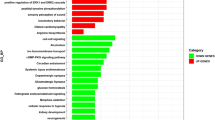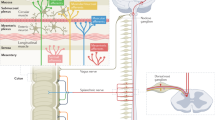Abstract
Abdominal pain is common across organic and functional gastrointestinal disorders. For example, most patients with inflammatory bowel disease (IBD) report experiencing abdominal pain related to their condition, and many functional disorders are diagnosed by the presence of pain. Although great strides have been made in the treatment of IBD and functional disorders such as irritable bowel syndrome (IBS), pain continues to be a challenge for a significant number of patients refractory to treatment or experience pain during disease remission. This chapter describes our recent work which demonstrates how the use of human tissue from carefully phenotyped patients in combination with omics technology and assays of nociceptor signalling has enabled the identification of mediators (MMP-12) and mechanisms (PAR1, NaV1.9) responsible for the activation of colonic nociceptors in GI disease states, validating their utility as therapeutic targets for novel analgesic therapies. This process has been accelerated with the advent of next-generation sequencing which has facilitated detailed interactome analysis of putative signalling pathways in disease states as exemplified for prokineticin-2, highlighting the future opportunities for hypothesis-driven translational studies of visceral nociception in GI diseases, the findings from which should accelerate the development of visceral analgesics.
Access this chapter
Tax calculation will be finalised at checkout
Purchases are for personal use only
Similar content being viewed by others

References
Baker MD. Protein kinase C mediates up-regulation of tetrodotoxin-resistant, persistent Na+ current in rat and mouse sensory neurones. J Physiol. 2005;567:851–67.
Baker MD, Chandra SY, Ding Y, et al. GTP-induced tetrodotoxin-resistant Na+ current regulates excitability in mouse and rat small diameter sensory neurones. J Physiol. 2003;548:373–82.
Balemans D, Mondelaers SU, Cibert-Goton V, et al. Evidence for long-term sensitization of the bowel in patients with post-infectious-IBS. Sci Rep. 2017;7:1–11.
Barbara G, Wang B, Stanghellini V, et al. Mast cell-dependent excitation of visceral-nociceptive sensory neurons in irritable bowel syndrome. Gastroenterology. 2007;132:26–37.
Bautista DM, Jordt S-E, Nikai T, et al. TRPA1 mediates the inflammatory actions of environmental irritants and proalgesic agents. Cell. 2006;124:1269–82.
Bautzova T, Hockley JRF, Perez-Berezo T, et al. 5-oxoETE triggers nociception in constipation-predominant irritable bowel syndrome through MAS-related G protein-coupled receptor D. Sci Signal. 2018;11:1–35.
Bentley FH, Smithwick Reginald H. Visceral pain produced by balloon distention of the jejunum. Lancet. 1940;236:389–91.
Bielefeldt K, Davis B, Binion DG. Pain and inflammatory bowel disease. Inflamm Bowel Dis. 2009;15:778–88.
Blackshaw LA, Gebhart GF. The pharmacology of gastrointestinal nociceptive pathways. Curr Opin Pharmacol. 2002;2:642–9.
Brierley SM, Carter R, Jones W 3rd, et al. Differential chemosensory function and receptor expression of splanchnic and pelvic colonic afferents in mice. J Physiol. 2005;567:267–81.
Brierley SM, Hughes PA, Page AJ, et al. The ion channel TRPA1 is required for normal mechanosensation and is modulated by Algesic stimuli. Gastroenterology. 2009;137:2084–95.
Bueno L, Fioramonti J. Visceral perception: inflammatory and non-inflammatory mediators. Gut. 2002;51:i19–23.
Buhner S, Braak B, Li Q, et al. Neuronal activation by mucosal biopsy supernatants from irritable bowel syndrome patients is linked to visceral sensitivity. Exp Physiol. 2014;99:1299–311.
Caterina MJ, Leffler A, Malmberg AB, et al. Impaired nociception and pain sensation in mice lacking the capsaicin receptor. Science. 2000;288:306–13.
Cenac N, Andrews CN, Holzhausen M, et al. Role for protease activity in visceral pain in irritable bowel syndrome. J Clin Invest. 2007;117:636–47.
Cenac N, Bautzova T, Le Faouder P, et al. Quantification and potential functions of endogenous agonists of transient receptor potential channels in patients with irritable bowel syndrome. Gastroenterology. 2015;149:433–44.
Chung M-K, Jung SJ, Oh SB. Role of TRP channels in pain sensation. Adv Exp Med Biol. 2011;704:615–36.
Cibert-Goton V, Lam C, Lingaya M, et al. Pain severity correlates with biopsy- mediated colonic afferent activation but not psychological scores in patients with IBS-D. Clin Transl Gastroenterol. 2021;12:1–7.
Desormeaux C, Bautzova T, Garcia-Caraballo S, et al. Protease-activated receptor 1 is implicated in irritable bowel syndrome mediators–induced signaling to thoracic human sensory neurons. Pain. 2018;159:1257–67.
Gold MS, Gebhart GF. Nociceptor sensitization in pain pathogenesis. Nat Med. 2010;16:1248–57.
Heuberger DM, Schuepbach RA. Protease-activated receptors (PARs): mechanisms of action and potential therapeutic modulators in PAR-driven inflammatory diseases. Thromb J. 2019;17(4):1–24.
Hockley JRF, Boundouki G, Cibert-Goton V, et al. Multiple roles for NaV1.9 in the activation of visceral afferents by noxious inflammatory, mechanical, and human disease-derived stimuli. Pain. 2014;155:1962–75.
Hockley JRF, Taylor TS, Callejo G, et al. Single-cell RNAseq reveals seven classes of colonic sensory neuron. Gut. 2019;68:633–44.
Hughes PA, Brierley SM, Martin CM, et al. Post-inflammatory colonic afferent sensitisation: different subtypes, different pathways and different time courses. Gut. 2009;58:1333–41.
Jacenik D, Fichna J, Małecka-Wojciesko E, et al. Protease-activated receptors - key regulators of inflammatory bowel diseases progression. J Inflamm Res. 2021;14:7487–97.
Jones RCW 3rd, Xu L, Gebhart GF. The mechanosensitivity of mouse colon afferent fibers and their sensitization by inflammatory mediators require transient receptor potential vanilloid 1 and acid-sensing ion channel 3. J Neurosci. 2005;25:10981–9.
Klooker TK, Braak B, Koopman KE, et al. The mast cell stabiliser ketotifen decreases visceral hypersensitivity and improves intestinal symptoms in patients with irritable bowel syndrome. Gut. 2010;59:1213–21.
Kuiken SD, Linderboom R, Tytgat GN, et al. Relationship between symptoms hypersensitivity to rectal distension in patients with irritable bowel syndrome. Aliment Pharmacol Ther. 2005;22:157–64.
Liu B, Linley JE, Du X, et al. The acute nociceptive signals induced by bradykinin in rat sensory neurons are mediated by inhibition of M-type K+ channels and activation of Ca2+-activated Cl− channels. J Clin Invest. 2010;120:1240–52.
Longstreth GF, Thompson WG, Chey WD, et al. Functional bowel disorders. Gastroenterology. 2006;130:1480–91.
Maingret F, Coste B, Padilla F, et al. Inflammatory mediators increase NaV1.9 current and excitability in nociceptors through a coincident detection mechanism. J Gen Physiol. 2008;131:211–25.
Moriyama T, Higashi T, Togashi K, et al. Sensitization of TRPV1 by EP1 and IP reveals peripheral nociceptive mechanism of prostaglandins. Mol Pain. 2005;1(3):1–13.
Peiris M, Bulmer DC, Baker MD, et al. Human visceral afferent recordings: preliminary report. Gut. 2011;60:204–8.
Rao SSC, Read NW, Davison PA, et al. Anorectal sensitivity and responses to rectal distention in patients with ulcerative colitis. Gastroenterology. 1987;93:1270–5.
Ray BS, Neill CL. Abdominal visceral sensation in man. Ann Surg. 1947;126:709–23.
Ritchie J. Pain from distension of the pelvic colon by inflating a balloon in the irritable colon syndrome. Gut. 1973;14:125–32.
Shinoda M, La J-H, Bielefeldt K, et al. Altered purinergic signaling in colorectal dorsal root ganglion neurons contributes to colorectal hypersensitivity. J Neurophysiol. 2010;104:3113–23.
Tranter M, Barakat F, Dogra H, et al. P086 MMP-12, a novel mediator of nociception in Crohn’s disease. J Crohn’s Colitis. 2017;11:S120.
Woods CG, Babiker MOE, Horrocks I, et al. The phenotype of congenital insensitivity to pain due to the NaV1.9 variant p.L811P. Eur J Hum Genet. 2015;23:561–3.
Wynn G, Rong W, **ang Z, et al. Purinergic mechanisms contribute to mechanosensory transduction in the rat colorectum. Gastroenterology. 2003;125:1398–409.
Author information
Authors and Affiliations
Corresponding author
Editor information
Editors and Affiliations
Rights and permissions
Copyright information
© 2023 The Author(s), under exclusive license to Springer Nature Switzerland AG
About this chapter
Cite this chapter
Higham, J., Gupta, R., Bulmer, D.C. (2023). Visceral Nociception in Gastrointestinal Disease. In: Brierley, S.M., Spencer, N.J. (eds) Visceral Pain. Springer, Cham. https://doi.org/10.1007/978-3-031-25702-5_8
Download citation
DOI: https://doi.org/10.1007/978-3-031-25702-5_8
Published:
Publisher Name: Springer, Cham
Print ISBN: 978-3-031-25701-8
Online ISBN: 978-3-031-25702-5
eBook Packages: Biomedical and Life SciencesBiomedical and Life Sciences (R0)



